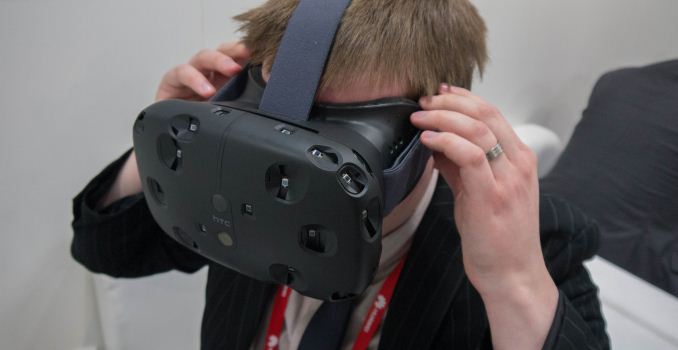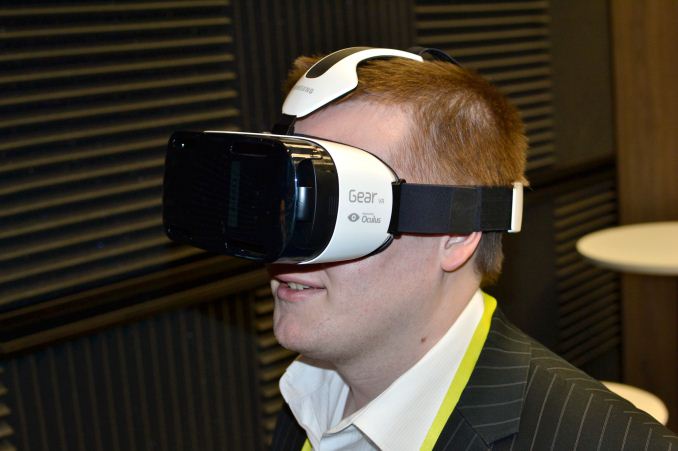IFA 2016: Examining the Malaise of Bargain Basement Virtual Reality
by Dr. Ian Cutress on September 9, 2016 9:00 AM EST
For the show this year, I left one day free just to roam freely around the show, looking for some insights or random bonus stories. One of the things that piqued my interest upon entering the International Tent was a number of VR headsets. It could be argued that the headsets that require a smartphone are a dime a dozen, so I scouted around for the VR headsets that were designed to come contained as all-in-one units and offer an untethered experience. A couple of the big names are touting untethered VR, so I asked around at a number of booths to look into the cheaper side of VR. For $100, you don’t get a lot.
For an all-in-one Virtual Reality headset, the core components include the screen resolution, screen size, screen quality, the SoC, the memory, the battery, the connectivity (wireless/LTE, USB etc.), the feel and the function of the headset are all key factors to get it right. In the myriad of six/seven headsets I was able to find in a morning at IDF, it was clear that almost all of these areas are gutted into the low-performance rung in order to meet very strict price points.
If we nostalgically look back to when Oculus was just starting, there were some clear defined goals that had to be achieved. For the most part they revolved around being to use the headset, eliminate nausea, and provide an immersive user experience. Millions of dollars and several prototypes later gave us the Rift, along with the Vive and other head-mounted displays (HMDs) that rely on a super powerful system behind it.
On the other side is Samsung Gear VR, leveraging an already owned premium smartphone with a reasonable element of a headset to house it – the smartphone is at a similar power budget to what you would expect to be the limit in front of the face. What these ‘bargain basement’ headsets try to do is try to provide all the hardware inside the headset, similar to the Gear VR, including SoC and battery and everything else, but for the same price as the Gear VR (minus smartphone). Of course, at the other end is Google Cardboard.
The true comparison points to these all-in-one VR systems could be the backpack VR units that house a laptop-like device, but these still require cables. The better comparison is to Intel’s Project Alloy, announced at IDF, or Qualcomm’s new VR820 platform, however both use internal and external cameras as part of a mixed VR/AR concept called mixed reality. We’ve seen other things like the SulonQ, which uses older AMD embedded parts, to provide the horsepower for an untethered VR experience as well. But all three of these are premium devices still in development. The goal of these cheaper headsets is to be super low cost, which also means there’s lots of competition to shave tenths of a cent off of the production costs.
As an additional caveat, the makers of these headsets I found on the show floor are the original design manufacturers, or ODMs. They are looking for bigger companies to order thousands of units and brand them under their own name, and subsequently deal with sales and distribution.












59 Comments
View All Comments
Mugur - Monday, September 12, 2016 - link
IFA 2016? It's in the title...rahulsolanki1818 - Monday, September 12, 2016 - link
virtual reality is an awesome technology , it has improved the way of watching videos.Shadowmaster625 - Monday, September 12, 2016 - link
2.7 million by the end of 2017? At that rate it is going to be 5 years before we see a true killer app for VR. It is going to take a Nintendo-level innovation to actually speed this up.StrangerGuy - Tuesday, September 13, 2016 - link
Given how absolutely tiny the VR market is, I will go as far as to say any VR solution without a first party killer app will be an automatic market failure (like the writeup mentioned, good luck with the chicken and egg problem as a pure HW or SW VR vendor). That only leaves the current gen consoles and Apple with any chance of mainstream success at VR.Nenad - Monday, September 12, 2016 - link
I have GearVR, and I can see advantages of why this can be better than Samsung GearVR - and it is not the price. Basically, this would be "always ready" for use, unlike GearVR where you need to unlock, dock, then undock and unlock again (common GearVR bug that asks to 'unlock' already unlocked phone), then optionally clean phone display etc...
Often I had idea to use GearVR for some short gaming or 3D movie, and decided against due to this 'preparation' time. It is same reason as why I never used my PC for movie watching on TV, even if streaming works - too much time in preparations (set secondary display, change TV source...). It is amazing how important it is for things to "just work" with push of a button, without any complex preparation needed, if people are to use that thing frequently.
mebalzer - Monday, September 12, 2016 - link
As some who develops both hardware and software for VR and Mixed Reality, I appreciate great articles like this to confirm my own findings. Frankly buy a one of the Chinese Snapdragon 820/821 phones from LeTV, OnePlus3. Xiaomi, ZTE, or ZUK or the new Nexus/Pixel that will be Google Daydream compatible with an HMD shell and call it a day. Trying to push more than 60 fps on a mobile platform is hard if you want more than simple shaders and geometry and frankly anymore than that strapped to your head makes no sense. I would rather see more HMD designs like the Pico NEO which tethers the processor/battery/control and keeps the headset light.I can't say a lot right now, but a dual component design that I feel will afford you the ability to use a more powerful SOC (one we haven't seen in a phone), improved (light and comfortable) HMD design, display panel and optics, IMU, positional tracking and a power source without making the thing look the monstrosities from from Intel & AMD is really the only the course one can go at this time if you want to compete with the HTC Vive or even the Sony Playstation VR.
Sadly, getting it to a price point that doesn't make someone have second thoughts that they should have went with a dedicated system is the real challenge and frankly we are not there yet.
By the way, a little sneak peek at my NEODiVR uPLAy http://neodivr.com/images/NEODiVR-uPLAy-280.gif
cptnjarhead - Thursday, September 15, 2016 - link
I have the G7 edge with gearVR. I absolutely love it! Oculus store is great, and the content grows all the time. One of the best apps is the Netflix app. End space (not a rail shooter) is a really fun game, coupled with a Bluetooth controller you really get a great space flight experience. Affected the manor, well my daughter watches scary movies all the time without flinching, and she only lasted 2 minutes with affected, she threw the whole headset off. Sure the graphics are not Vive, or rift, but the whole system works like a console. easy menus and setup. Thats why i feel sony will have the best VR for the money. Content, cost and ease of use will be the winner. If successful, that will push more development to PC and other platforms and in a few years, the current high end VR platforms will seem archaic.serendip - Thursday, September 22, 2016 - link
I just got a VR Box unit as seen in the first image. It's like a fancier Google Cardboard device, with two lenses and a smartphone holder. Surprisingly it's not bad, I use it with a Xiaomi Redmi Note 3 and the resolution is decent. My favorite app so far is a solar system flythrough - the planets look huge hanging in 3D space, although the phone gets burning hot after 10 minutes of play. Movies don't look good on this because the pixels are visible.kompanions - Friday, May 1, 2020 - link
Virtual Reality is one of the trending buzzwords of the last couple of years, and yet many people say it still has a way to go until it "catches".